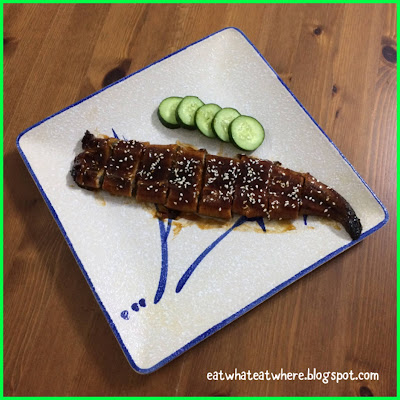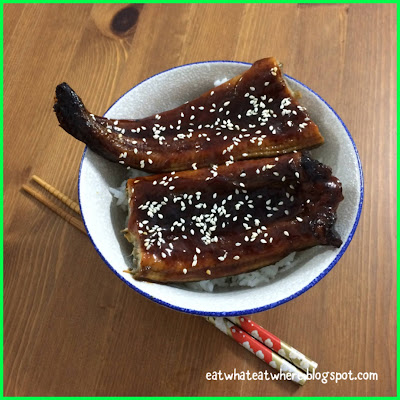Vfresh is an online supplier of fresh produce, particularly seafood, that I came across recently. They get their weekly supply from local fishing villages around Selangor. There was once when I contacted the 'boss' and he so happened to be in Sekinchan sourcing for his weekly supply of fresh seafood.
I've since made my second order from them recently during CNY....got more of their refreshingly sweet pineapple juice...and received a free MD2 pineapple (surprisingly). I think it was because I mentioned that one of the pineapples I got from them previously was slightly spoilt at the bottom. I just wanted him to know (about his produce) and wasn't looking to be given a replacement but appreciated the nice gesture nevertheless.
When I made my first order from Vfresh, I got myself some Unagi Kabayaki or Japanese Grilled Eel (RM22) to try too. When it arrived and I looked at the packaging, I realised they were from Piau Kee, a live and frozen seafood supplier/distributor.
Cooking instructions are provided on the packaging and you can choose a method that best suits you. Method 1 - You can submerge the sealed frozen eel package into boiling water and cook for about 6 minutes. Method 2 - Or you can defrost the frozen eel in its package first in the microwave for 2 minutes and then microwave it for a further 3 minutes. Method 3 - You can also slide the frozen eel onto a baking tray and bake at 180°C for about 8 minutes.
Which method was I most comfortable with? Obviously the last method as the first two involved cooking the frozen eel in its plastic packaging before sliding the eel out of its packet and onto a serving plate. I guess I was just being paranoid. I shouldn't be, after all sous vide is also done this way but that is done with food grade vacuum sealing bags, of course. I wasn't too confident seeing that this had coloured printing on the packaging. I once dropped a seasoning packet into my boiling instant noodles and I had to discard the whole pot! >_<
I decided to defrost the unagi in the fridge and cook it in the oven at 200°C (hoping for a better charring at a higher temperature) and it was done in just 5 minutes (since it was already defrosted). It came out looking wonderful...like the real McCoy! ;) As you can see, it's quite a large piece...for comparison purposes, it's as long as a pair of Japanese chopsticks. You can serve (and eat) it on its own (with a sprinkle of toasted sesame seeds).
Or make it into a bowl of unagi don...full portion....for those with a ferocious appetite! Taste wise, the unagi was soft textured (but a little gummy if you ask me) and it did achieve a bit of charring (but not much). Even though there was a little charring, there wasn't any charred taste as you'd come to expect if it was grilled on an open fire as how it is often cooked. This unagi had a bit too much skin (in my opinion) which was rather chewy.
But if you're not that big an eater, half portion is probably sufficient. I actually delayed cooking this for a while until my bottle of mirin from Shopee arrived. As can be seen from the packet, this unagi came with sauce but I was afraid it won't be enough....but it was. So no need to make your own unagi sauce though the sweet, caramelised sauce with its thick consistency I found to be too sweet for me (perhaps next time I should dilute it with a bit of water). When I slid the unagi from the packet onto the tray for cooking, I didn't pour out all the sauce but only added it in the last 2 minutes so that the sauce won't dry up during the grilling process.
If you happen to have any leftovers (and that's a big 'if'), the unagi keeps pretty well in the fridge for eating later. You just need to reheat it in the microwave...and it's good enough for your food prep lunch the next day.
If you ask me, this cheap (and frozen) unagi is just not in the same league as those we order from Japanese restaurants. Those are soft and delicately textured, not with a somewhat gummy texture, and the way they're grilled over an open fire means you get that lovely charred taste + the unagi sauce is also well balanced.
But at RM22, this unagi is good enough for two portions of unagi donburi making the cost only RM11 a bowl. Now where are we ever going to get a bowl of unadon at this price when we're more accustomed to paying anywhere between RM30 - RM50 (the average priced ones) at Japanese restaurants (there are also premium ones that easily cost more than RM50) although it's probably not fair to compare their quality directly to those offered by restaurants due to the vast difference in prices.
In the end, would this be an unagi I would re-order. Yes and no. Yes, if I'm looking for a cheap alternative (as a home meal)....and no, if I want to taste good quality unagi like those I'm excited to eat at Japanese restaurants. So, hold your horses if you think you don't ever need to order unagi again when eating out. This one isn't quite of the same level unfortunately...but, if you're willing to lower your expectations, this unagi is just pleasant enough to be acceptable. ^_~











Ok, I have some orders for next week and I am going to include this unagi and see how I feel about it hee..hee...
ReplyDeleteHah...hah....good luck! Do let me know what you think of it. ^_~
DeleteI dare not re-heat food in plastic packaging too, although "it's okay" to be done so as per instruction given, just feel unsafe, like what you said. :P
ReplyDeleteActually I'm happy with the this type of frozen unagi as they are 70-80% the same (in terms of flavour and texture) with those I had in Japanese restaurants. Perhaps I not yet have chance to eat those higher quality unagi kabayaki. LOL
Well, it's all in the expectations, I suppose. If you're happy with the frozen unagi being at 70-80% similar in taste and texture of those you had at restaurants, then by all means continue to enjoy it.
DeleteWhat do you think of food being done (in plastic) sous vide style then? ;)
Unagi is always so easy to prepare for quick home made lunch/dinner, love it, always have 1-2 in the freezer "just in case"
ReplyDeleteOh yes, I do like the idea of having them in the freezer too for those "just in case" days. ^.^
DeleteThis gummy unagi topic made me think a lot. I believe that for cheaper and easier reasons to cook by ourselves at home, we cannot expect anything near restaurant or Michelin standard. Just like my wife's Poon Choi dish, it might look attractive but we cannot beat the Putien's taste and quality at RM988 per pot for 10.
ReplyDeleteI felt so guilty to read about the plastics being boiled or microwaved. Back in US, I had 2 miscrowaves in my kitchen and I even boiled my morning beverages using a microwave! How unhealthy and silly of me just to ape the ang mohs. Not to mention, we bought so much food and pizza that popped the whole box complete with plastics to heat in microwave. Oh God! No wonder my guts are all screwed up today.
I believe it's safe to use microwave for cooking and reheating...provided we follow instructions and use them correctly with the microwave safe materials & cookware. If we want to be wary of microwave cooking, we'd also have a bone to pick with other forms of cooking like open/direct fire grilling and sous vide, right? I believe in sous vide as those are done with food grade vacuum sealing bags...I just don't trust those with printed packaging.
DeleteOf course I don't expect this unagi to be of restaurant-quality standard since I only paid RM22 for a full portion. I will turn to this when I want cheaper unagi at home...hee..hee! ;)